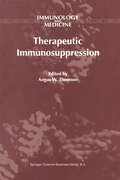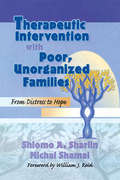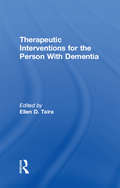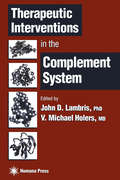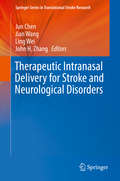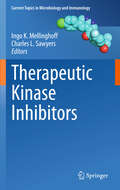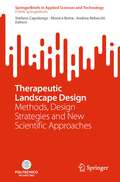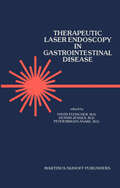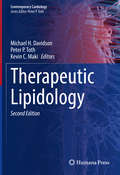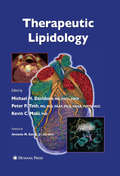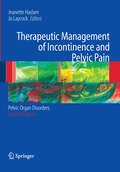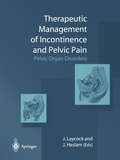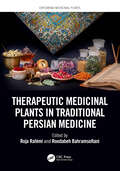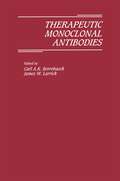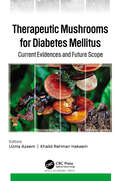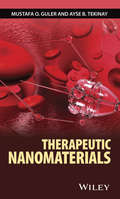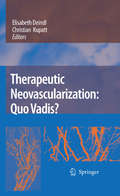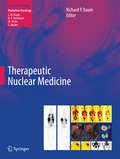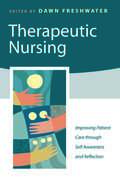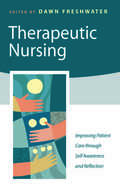- Table View
- List View
Therapeutic Intervention with Poor, Unorganized Families: From Distress to Hope
by Terry S Trepper Shlomo A SharlinTherapeutic Intervention with Poor, Unorganized Families: From Distress to Hope offers you integrated theories, practice, and research to provide you with the tools to be more effective when dealing with families in crisis. Therapeutic Intervention with Poor, Unorganized Families explores the decline of families into extreme distress and helps you to determine the best intervention for that particular family, as no one single method can be prescribed for all families. Therapists as well as clients favor the joint-goal intervention you will discover through this book, which is carried out mostly in the family home where the therapist can delegate authority as a means of strengthening and preserving the family. Through Therapeutic Intervention with Poor, Unorganized Families, you will receive a plethora of ideas which consist of multiple intervention techniques and alternatives for intervention, including:learning to organize institutions in the community to participate in getting families in extreme distress out of their long and perpetual predicament teaching you how cooperation between various government organizations, public and private, can be solicited for the welfare of these families offering you an anthro-psycho-social model of intervention that you will find effective in your own practice examining case studies so you can see how the new model works in real-life settingsTherapeutic Intervention with Poor, Unorganized Families is unique because not only does it offer you help with supervision and training aspects, but because it also ends with a qualitative and quantitative research evaluation of this new model. Comprehensive and thorough, this book deals with the difficulties that may arise to interfere with the effectiveness of the intervention so you can learn from it and prevent further crisis. Therapeutic Intervention with Poor, Unorganized Families is a must for anyone working with families in crisis.
Therapeutic Intervention with Poor, Unorganized Families: From Distress to Hope
by Terry S Trepper Shlomo A SharlinTherapeutic Intervention with Poor, Unorganized Families: From Distress to Hope offers you integrated theories, practice, and research to provide you with the tools to be more effective when dealing with families in crisis. Therapeutic Intervention with Poor, Unorganized Families explores the decline of families into extreme distress and helps you to determine the best intervention for that particular family, as no one single method can be prescribed for all families. Therapists as well as clients favor the joint-goal intervention you will discover through this book, which is carried out mostly in the family home where the therapist can delegate authority as a means of strengthening and preserving the family. Through Therapeutic Intervention with Poor, Unorganized Families, you will receive a plethora of ideas which consist of multiple intervention techniques and alternatives for intervention, including:learning to organize institutions in the community to participate in getting families in extreme distress out of their long and perpetual predicament teaching you how cooperation between various government organizations, public and private, can be solicited for the welfare of these families offering you an anthro-psycho-social model of intervention that you will find effective in your own practice examining case studies so you can see how the new model works in real-life settingsTherapeutic Intervention with Poor, Unorganized Families is unique because not only does it offer you help with supervision and training aspects, but because it also ends with a qualitative and quantitative research evaluation of this new model. Comprehensive and thorough, this book deals with the difficulties that may arise to interfere with the effectiveness of the intervention so you can learn from it and prevent further crisis. Therapeutic Intervention with Poor, Unorganized Families is a must for anyone working with families in crisis.
Therapeutic Interventions for the Person With Dementia
by Ellen D TairaThis pioneering volume taps the resources and skills of top rehabilitation professionals and applies them to the person with Alzheimer’s disease and other related dementias.
Therapeutic Interventions for the Person With Dementia
by Ellen D TairaThis pioneering volume taps the resources and skills of top rehabilitation professionals and applies them to the person with Alzheimer’s disease and other related dementias.
Therapeutic Interventions in the Complement System (Contemporary Immunology)
by John D. Lambris V. Michael HolersA team of expert investigators and clinical researchers comprehensively review complement's basic biology, its role in disease, methods to measure its activity, and strategies for its inhibition in patients. Each chapter focuses on a specific area of basic and applied complement biology, spelling out the activation pathways and complement receptors. Informative animal models are discussed in detail, including the relative values of each model and the important interspecies differences that can distort the interpretation of preclinical studies. The emphasis throughout is on the pros and cons of the therapeutic use of recombinant complement inhibitors in specific diseases. Cutting-edge and innovative, Therapeutic Interventions in the Complement System highlights for today's researcher and biotechnologist effective strategies of drug discovery and development that are producing valuable new complement inhibitors for the treatment of a wide variety of clinically important diseases.
Therapeutic Intranasal Delivery for Stroke and Neurological Disorders (Springer Series in Translational Stroke Research)
by Jun Chen Jian Wang Ling Wei John H. ZhangThe blood-brain-barrier serves to encapsulate and protect the central nervous system, but it also presents a major barricade to therapeutic drug delivery. Poor penetration is the most common hurdle to translating a promising experimental therapy that uses invasive delivery methods to a clinically useful application. In the last 10 years, intranasal delivery of various therapeutic compounds including small chemicals, large proteins, and even stem cells has proven to be very effective in bypassing the blood-brain-barrier and has led to some important advances in translational research for stroke and other neurological diseases. The proposed book will bring together reports from various labs around the world who have had successes in pre-clinical studies of intranasal therapies for various diseases including adult and perinatal stroke, Alzheimer's, Parkinson's, and others.
Therapeutic Kinase Inhibitors (Current Topics in Microbiology and Immunology #355)
by Ingo K. Mellinghoff and Charles L. SawyersCancer drug development is currently undergoing a profound shift. Drugs targeting fundamental cellular processes such DNA-replication and microtubule function, often referred to as “chemotherapy” and still the backbone of most cancer treatment regimens, are increasingly being complemented by or replaced with kinase inhibitors. This new class of drugs targets enzymes which provide growth and survival signals to cancer cells by transferring phosphate groups from Adenosine-5'-triphosphate (ATP) to other proteins, lipids, nucleotides, and carbohydrates. This book summarizes the current state of kinase inhibitor therapy for cancer. Successful drug development relies on the expertise and dedication of many experts. To reflect this team approach to finding new kinase inhibitors and defining their optimal use for cancer treatment, the editors invited experts in academia and pharmaceutical industry to share their insights into various aspects of this process, ranging from the first chemical screens, to preclinical testing and disease-focused clinical drug development. The editors and authors hope these lessons will be instructive for the novice as well as the expert.
Therapeutic Landscape Design: Methods, Design Strategies and New Scientific Approaches (SpringerBriefs in Applied Sciences and Technology)
by Stefano Capolongo Andrea Rebecchi Monica BottaThrough an approach strongly oriented to socio-health contexts and healthcare facilities, with multidisciplinary contributions on the methodological and technical aspects, or legislative issues, the book provides tools and design strategies to plan and realize therapeutic places and healing gardens for care, rehabilitation, interaction, and social inclusion. It addresses all the technical and medical professionals - like Architects, Urban Planners, Agronomist, Sociologists, Epidemiologists, Public Health experts, Policy Makers, etc. - wishing to explore the link between built environment, well-being, and health, referring in particular to the direct relationship between places and therapy.
Therapeutic Laser Endoscopy in Gastrointestinal Disease (Developments in Gastroenterology #4)
by PeterBright-Asare DennisJensen DavidFleischerThe endoscopic use of lasers in the treatment of gastrointestinal d~seases began within the last decade and has evolved rapidly. Work is now being done at more than 150 centers in Europe, the United States, Japan and the rest of the world. To date no publi cation has defined the state of the art. This text attempts to fill that void. To disseminate information about therapeutic laser endoscopy, an increasing number of short courses have been sponsored in the United States wherein the attendee hears didactic lectures, views video tapes, and in addition, has the opportunity to have a "hands-on" experience with endoscopic laser therapy in the animal labs. This book is an expansion of the material presented in one such course sponsored by The Cook County Hospital in Chicago, Illinois, in October, 1982. The course was organized by Peter Bright-Asare, M. D. , Chairman of Gastroenterology at the time of the course and chaired by Dr. Bright-Asare and myself. Some of the lectures from the course have been broadened and formalized. Other chapters were invited and added. Also included are group discussions about issues that are either controversial or undefined. Attempts were made to secure consensus opinion from experienced investigators in areas where no hard scientific experimental or clinical data exists. The contributors have a wide range of interest and expertise. Dr.
Therapeutic Lipidology (Contemporary Cardiology)
by Michael H. Davidson Peter P. Toth Kevin C. MakiThis book is an up-to-date and comprehensive reference on lipidology. It will serve as a stimulus to the reader to continue to learn about the ever changing and fascinating field of therapeutic lipidology. It will also empower readers to improve and extend the lives of the patients they so conscientiously serve.
Therapeutic Lipidology (Contemporary Cardiology)
by Michael Davidson Peter P. Toth Kevin C. MakiThis book is an up-to-date and comprehensive reference on lipidology. It will serve as a stimulus to the reader to continue to learn about the ever changing and fascinating field of therapeutic lipidology. It will also empower readers to improve and extend the lives of the patients they so conscientiously serve.
Therapeutic Management of Incontinence and Pelvic Pain: Pelvic Organ Disorders
by J. Haslam J. LaycockThis 2nd revised edition covers management and treatment of bladder and bowel dysfunctions in men and women, pelvic organ prolapse, issues concerning the elderly, neurologically impaired patients and those with pelvic pain. New chapters cover quality of life, treatment of bladder and bowel dysfunction in children, the history of pelvic floor muscle exercise and manual therapy. The use of real-time ultrasound to evaluate pelvic floor muscle contractility is discussed, and a new section covers ethical issues in the management of incontinence. This is a useful reference and practical guide for health professionals dealing with incontinence and pelvic floor disorders.
Therapeutic Management of Incontinence and Pelvic Pain: Pelvic Organ Disorders
by JeanetteHaslam JoLaycockAs medical knowledge advances we tend to compartmentalise our specialties into smaller units; but, hand in hand with this, there is a growing understanding between the different disciplines within the caring professions. Thus we are able to share our special skills to the benefit of patients. This book is an excellent example of the advantage of interdisciplinary communication and demonstrates a refreshing holistic approach to the problems of incontinence and pelvic pain. Written with physiotherapists in mind, the editors have invited contributions from many distinguished experts in their own field. These have been compiled into a comprehensive book, which will appeal to many healthcare professionals. I have had great pleasure in reading this book. During the time that I have been involved with 'pelvic dysfunction' there have been many exciting advances. These are all included in a most readable sequence, some presented with a refreshing new twist. In particular, I would like to bring to your attention the section on 'pelvic pain'. Because of our lack of understanding it has been a problem that is too often ignored and here at last are some practical ideas for therapeutic management. There is still much progress to be made in the field of incontinence and pelvic pain and as yet, no editors can be expected to produce a definitive work. However, I would like to recommend this book most strongly. It has a new approach to this topic, which is still a major problem for many people.
Therapeutic Medicinal Plants in Traditional Persian Medicine (Exploring Medicinal Plants)
by Roja Rahimi Roodabeh BahramsoltaniTraditional Persian Medicine (TPM) is one of the oldest medical doctrines, globally known due to pioneering physicians and scientists. The greatest source of natural medicines in TPM originates from medicinal plants. Therapeutic Medicinal Plants in Traditional Persian Medicine provides a background on the history of TPM, as well as an introduction to 40 of the most popular medicinal plants used in TPM. It is a practical guide for readers interested in medicinal plants used in the prevention, management, and treatment of different diseases.Features: Includes both traditional therapeutic applications and modern evidence/ uses Makes a comparison between preclinical and clinical studies Provides information on major chemical constituents, therapeutic uses, adverse reactions, and safety for each plant species A volume in the “Exploring Medicinal Plants” series, this book is a valuable resource for researchers, students, academicians, and scientists dealing witth medicinal plants, as well as for those interested in the fields of pharmacognosy, naturopathy, phytotherapy, and traditional medicines.
Therapeutic Medicinal Plants in Traditional Persian Medicine (Exploring Medicinal Plants)
Traditional Persian Medicine (TPM) is one of the oldest medical doctrines, globally known due to pioneering physicians and scientists. The greatest source of natural medicines in TPM originates from medicinal plants. Therapeutic Medicinal Plants in Traditional Persian Medicine provides a background on the history of TPM, as well as an introduction to 40 of the most popular medicinal plants used in TPM. It is a practical guide for readers interested in medicinal plants used in the prevention, management, and treatment of different diseases.Features: Includes both traditional therapeutic applications and modern evidence/ uses Makes a comparison between preclinical and clinical studies Provides information on major chemical constituents, therapeutic uses, adverse reactions, and safety for each plant species A volume in the “Exploring Medicinal Plants” series, this book is a valuable resource for researchers, students, academicians, and scientists dealing witth medicinal plants, as well as for those interested in the fields of pharmacognosy, naturopathy, phytotherapy, and traditional medicines.
Therapeutic Monoclonal Antibodies
by James W. Larrick C. BorrebaeckA review of therapeutic antibodies which have commercial potential. It discusses PCR cloning of Igs, immortalization by gene transfer, scale up production, infectious diseases, viruses, bacteria, parisites, inflammation/immunology, blood grouping, cells, cytokines, tumours and MDR.
Therapeutic Mushrooms for Diabetes Mellitus: Current Evidences and Future Scope
by Uzma Azeem Khalid Rehman HakeemThis new book provides valuable insight into the role of mushrooms in the treatment of diabetes mellitus. Mushrooms are enriched with various bioactive constituents with antidiabetic efficacy such as polysaccharides, terpenes, sterols, etc. The extracts as well as bioactive constituents through different mechanisms exhibit antidiabetic action. Medicinal mushrooms such as Ganoderma lucidum, Innotus obliquus, Grifola frondosa, Phellinus species, etc. are considered in this volume for their beneficial qualities toward the mitigation of the disease. The volume considers mushroom powders, mushroom extracts, and their bioactive components for the management of diabetic syndrome. It presents various in vitro, in vivo, and clinical studies on lowering hyperglycemia and other diabetes associated with secondary abnormalities as well as provides information regarding mushroom-based antidiabetic market products.
Therapeutic Mushrooms for Diabetes Mellitus: Current Evidences and Future Scope
This new book provides valuable insight into the role of mushrooms in the treatment of diabetes mellitus. Mushrooms are enriched with various bioactive constituents with antidiabetic efficacy such as polysaccharides, terpenes, sterols, etc. The extracts as well as bioactive constituents through different mechanisms exhibit antidiabetic action. Medicinal mushrooms such as Ganoderma lucidum, Innotus obliquus, Grifola frondosa, Phellinus species, etc. are considered in this volume for their beneficial qualities toward the mitigation of the disease. The volume considers mushroom powders, mushroom extracts, and their bioactive components for the management of diabetic syndrome. It presents various in vitro, in vivo, and clinical studies on lowering hyperglycemia and other diabetes associated with secondary abnormalities as well as provides information regarding mushroom-based antidiabetic market products.
Therapeutic Nanomaterials
by Mustafa O. Guler Ayse B. TekinayAddressing a cutting-edge, multidisciplinary field, this book reviews nanomaterials and their biomedical applications. It covers regeneration, implants, adhesives, and biosensors and strategies for more efficient therapy, diagnosis, and drug delivery with the use of nanotechnology. • Addresses the increasing demand for nanomedicine in a cutting-edge, multidisciplinary field• Introduces concepts, strategies, and requirements of developing materials• Discusses hot topics in drug delivery, such as neural regeneration, cartilage regeneration, bone tissue regeneration, dental regeneration, biomedical imaging, tissue adhesives and biosensors• Includes a chapter about nanotoxicology to help readers further understand the biocompatability of nanomaterials
Therapeutic Nanomaterials
by Mustafa O. Guler Ayse B. TekinayAddressing a cutting-edge, multidisciplinary field, this book reviews nanomaterials and their biomedical applications. It covers regeneration, implants, adhesives, and biosensors and strategies for more efficient therapy, diagnosis, and drug delivery with the use of nanotechnology. • Addresses the increasing demand for nanomedicine in a cutting-edge, multidisciplinary field• Introduces concepts, strategies, and requirements of developing materials• Discusses hot topics in drug delivery, such as neural regeneration, cartilage regeneration, bone tissue regeneration, dental regeneration, biomedical imaging, tissue adhesives and biosensors• Includes a chapter about nanotoxicology to help readers further understand the biocompatability of nanomaterials
Therapeutic Neovascularization – Quo vadis?
by Elisabeth Deindl Christian KupattThis collection of current and future concepts of neovascularization offers fascinating insights into refining a powerful therapeutic tool which has not yet had the chance to live up to the expectations and needs of the medical community. It examines current refinements in the fundamental concept of neovascularization and describes the most recent developments, which in the future might pave the way towards a new era of therapeutic applications.
Therapeutic Nuclear Medicine (Medical Radiology)
by Richard P. BaumThe recent revolution in molecular biology offers exciting new opportunities for targeted radionuclide therapy. This up-to-date, comprehensive book, written by world-renowned experts, discusses the basic principles of radionuclide therapy, explores in detail the available treatments, explains the regulatory requirements, and examines likely future developments. The full range of clinical applications is considered, including thyroid cancer, hematological malignancies, brain tumors, liver cancer, bone and joint disease, and neuroendocrine tumors. The combination of theoretical background and practical information will provide the reader with all the knowledge required to administer radionuclide therapy safely and effectively in the individual patient. Careful attention is also paid to the role of the therapeutic nuclear physician in coordinating a diverse multidisciplinary team, which is central to the safe provision of treatment.
Therapeutic Nursing: Improving Patient Care through Self-Awareness and Reflection
by Dawn Freshwater'I found the book to be fascinating and so thought provoking that it made me consider more carefully the text and prose to really understand what the author said. It is skilfully written, very readable and has implications for a wide range of people such as the undergraduate, practitioner, lecturer and researcher' - Accident and Emergency Nursing Gaining self-awareness is a vital aspect of professional development for all who work in the caring professions. In nursing especially, the ability to evaluate oneself affects all areas of practice, including direct patient care, working relationships with colleagues and maintaining one's own well-being in the often pressured environment of health care. This is an innovative text which explores the ways in which self-awareness can be used as a practical tool for continuing professional development and practice improvement. Divided into three parts, the book examines the role of the nurse as therapeutic practitioner, reflective learner and reflexive researcher. For all those wishing to develop their skills as autonomous, reflective, accountable practitioners, this book will be an inspiring read. It will be of immense use to those who teach and supervise nurses at all levels.
Therapeutic Nursing: Improving Patient Care through Self-Awareness and Reflection
by Dawn Freshwater'I found the book to be fascinating and so thought provoking that it made me consider more carefully the text and prose to really understand what the author said. It is skilfully written, very readable and has implications for a wide range of people such as the undergraduate, practitioner, lecturer and researcher' - Accident and Emergency Nursing Gaining self-awareness is a vital aspect of professional development for all who work in the caring professions. In nursing especially, the ability to evaluate oneself affects all areas of practice, including direct patient care, working relationships with colleagues and maintaining one's own well-being in the often pressured environment of health care. This is an innovative text which explores the ways in which self-awareness can be used as a practical tool for continuing professional development and practice improvement. Divided into three parts, the book examines the role of the nurse as therapeutic practitioner, reflective learner and reflexive researcher. For all those wishing to develop their skills as autonomous, reflective, accountable practitioners, this book will be an inspiring read. It will be of immense use to those who teach and supervise nurses at all levels.
